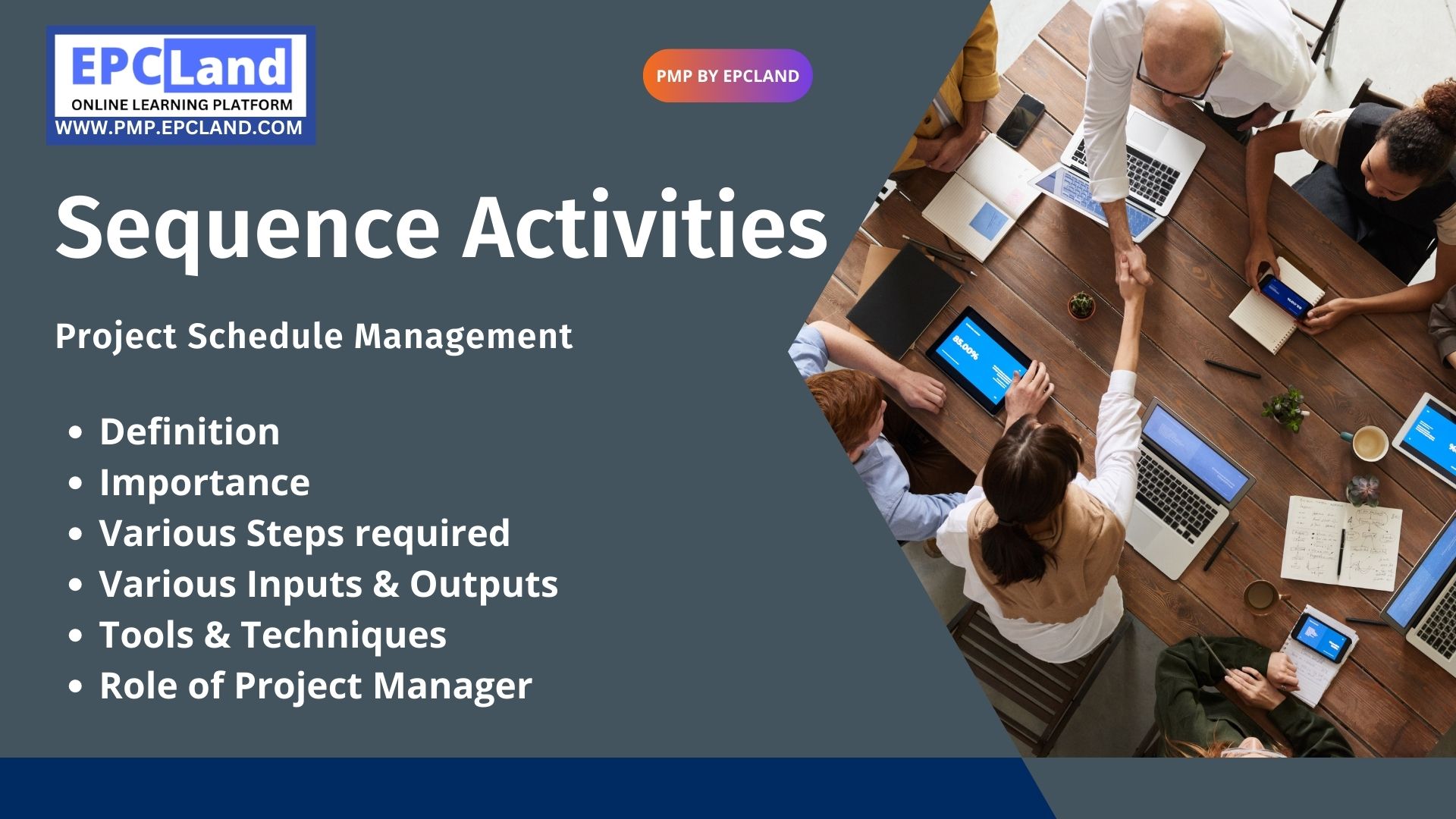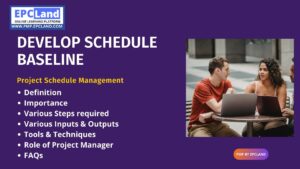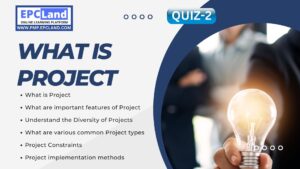Sequencing activities in project schedule management is crucial for the success of any project. A well-structured and organized schedule can ensure that tasks are completed on time and within budget. In this blog, we will explore the best practices for using a work breakdown structure (WBS), managing dependencies, allocating resources, and aligning activities with project objectives and deliverables. We will also examine common pitfalls to avoid and strategies for achieving optimal results. By understanding the importance of sequencing activities, you can improve your project management skills and increase the chances of project success.
What is the importance of Sequence Activities?
Sequencing activities in project schedule management is important for several reasons:
- It helps to ensure that tasks are completed in the correct order and at the appropriate time, allowing for a more efficient use of resources.
- It helps to identify and manage dependencies between tasks, which can impact the completion of a project.
- It helps to identify and resolve potential conflicts or bottlenecks in the schedule, which can impact the overall completion of a project.
- It allows for better communication and collaboration among project team members and stakeholders, which can lead to increased productivity and improved outcomes.
- It helps to ensure that project objectives and deliverables are met on time and within budget.
Attempt Quiz-1 on Sequence Activities Process
What are the various steps for “Sequence Activities?”
The steps for sequencing activities in project schedule management include:
- Identify activities: The first step is to identify all the tasks that need to be completed as part of the project. This is typically done using a work breakdown structure (WBS).
- Define dependencies: Once the activities have been identified, the next step is to define the dependencies between them. This includes identifying which tasks must be completed before or after other tasks, as well as identifying any external dependencies.
- Develop a logical sequence: Once the dependencies have been defined, the next step is to develop a logical sequence for completing the tasks. This includes determining the best order for completing the tasks and identifying any potential conflicts or bottlenecks in the schedule.
- Allocate resources: Once the sequence of tasks has been established, the next step is to allocate resources to the tasks. This includes identifying the resources required to complete each task and ensuring that they are available when needed.
- Create a schedule: Once the resources have been allocated, the next step is to create a schedule. This includes creating a detailed timeline for completing the tasks, including start and end dates, and identifying any critical paths or milestones.
- Review and update: The final step is to review and update the schedule on a regular basis. This includes monitoring progress, identifying and addressing any issues, and making adjustments as needed to ensure that the project stays on track.
What is the role of the Project Manager in Sequence Activities?
The project manager plays a critical role in sequencing activities in project schedule management. The main responsibilities of a project manager in this process include:
- Identifying and defining the tasks that need to be completed as part of the project and creating a work breakdown structure (WBS) to organize them.
- Identifying and defining the dependencies between tasks and resolving any conflicts or bottlenecks in the schedule.
- Allocating resources to tasks, including human resources, equipment, and materials, and ensuring that they are available when needed.
- Creating a detailed schedule, including start and end dates, and identifying critical paths and milestones.
- Monitoring progress and making adjustments to the schedule as needed to ensure that the project stays on track.
- Communicating with the project team, stakeholders, and stakeholders about the schedule and any changes or issues that may arise.
- Managing any risks that may arise from changes in the schedule or unforeseen events.
- Making sure the schedule is aligned with project objectives and deliverables, and that all the activities are contributing to achieving those objectives.
What are Tools & Techniques in Sequence Activities
There are several tools and techniques that can be used in the process of sequencing activities in project schedule management. Some of these include:
- Precedence Diagramming Method (PDM) or Activity on Node (AON): This method is used to identify and diagram the dependencies between tasks. It is a visual representation that shows the logical relationships between activities and helps to identify the critical path of the project.
- Gantt Charts: These are a type of bar chart that is used to display the schedule of a project. They are used to show the start and end dates of tasks and to identify the critical path and any potential schedule conflicts.
- Network Diagrams: These diagrams are used to show the logical relationships between activities and identify the project’s critical path. They can be created using PDM or AON and are helpful for identifying the dependencies between tasks.
- Resource leveling: This technique ensures that the resources are used efficiently and effectively throughout the project. It is used to avoid over-allocation of resources and it helps in identifying the critical path of the project.
- Three-point estimation: This technique is used to estimate the duration of a task. It involves using the best-case, most likely, and worst-case scenarios to estimate the duration of a task.
- Critical Chain Method: This method is used to plan and manage projects by identifying the critical path and allocating a buffer of time to protect the project schedule from unforeseen delays.
- Project management software: There is various software available in the market that can be used to sequence activities, such as Microsoft Project, Primavera P6, and Asana. This software can help to create and manage schedules, track progress, and identify potential issues and risks.
These tools and techniques can be used in combination to create an effective project schedule and to ensure that the project stays on track and is completed on time and within budget.
What are the various Inputs & outputs for Sequence Activities
Inputs for the process of sequencing activities in project schedule management include:
- Project scope statement: This document outlines the project’s goals, objectives, deliverables, and constraints. It is used to understand the overall project requirements and to identify the specific tasks that need to be completed.
- Work breakdown structure (WBS): This is a hierarchical breakdown of the project’s deliverables and activities. It is used to understand the specific tasks that need to be completed and the dependencies between them.
- Resource calendars: These calendars provide information about the availability of resources, such as personnel, equipment, and materials. They are used to schedule tasks and to identify potential resource conflicts.
- Activity attributes: These include information such as task duration, resource requirements, and any constraints or assumptions associated with the task.
Outputs of the sequence activities process include:
- Activity list: A comprehensive list of all the tasks required to complete the project.
- Activity attributes: Detailed information about each task, including duration, resource requirements, and any constraints or assumptions.
- Milestone list: A list of key project milestones, including the start and end dates for each task.
- Project schedule network diagrams: A visual representation of the logical relationships between activities and the critical path of the project.
- Project documents updates: Any changes made to the project scope statement, WBS, resource calendars, and other project documents will be updated.
- Project schedule: A detailed schedule of all the tasks required to complete the project, including start and end dates, durations, and resource requirements.
These outputs provide the necessary information to plan, manage, and execute the project effectively. They also serve as a basis for monitoring and controlling the project schedule.
Final Takeaway on Sequence Activities
Sequencing activities is a critical step in project schedule management that involves breaking down the project into smaller, manageable tasks and determining the logical relationships between these tasks. This process helps project managers create a clear and achievable project schedule, identify potential issues and conflicts, and use tools and techniques such as the work breakdown structure and project schedule network diagrams to create a visual representation of the project’s critical path and milestones. Overall, sequencing activities is an essential component of project management that is crucial for ensuring project success.
Attempt Quiz-2 on Sequence Activities Process
FAQs on Sequence Activities
Q: What is the purpose of sequencing activities in project management?
A: The purpose of sequencing activities is to break down the project into smaller, manageable tasks and determine the logical relationships between these tasks in order to create a clear and achievable project schedule.
Q: What are some tools and techniques used for sequencing activities?
A: Some common tools and techniques used for sequencing activities include the work breakdown structure, project schedule network diagrams, and critical path method.
Q: How do sequencing activities help in identifying potential issues and conflicts?
A: By breaking down the project into smaller tasks and determining the logical relationships between these tasks, sequencing activities can help identify potential issues and conflicts, such as resource constraints, and allow for proactive problem-solving.
Q: What is the role of the project manager in sequencing activities?
A: The project manager is responsible for leading the sequencing activities process and ensuring that the project schedule is clear, achievable, and aligns with the project’s objectives.
Q: What are the inputs and outputs of sequencing activities?
A: Inputs to sequencing activities include the project charter, scope statement, and work breakdown structure. Outputs include a project schedule, activity list, and activity attributes.
{ “@context”: “https://schema.org”, “@type”: “FAQPage”, “mainEntity”: [{ “@type”: “Question”, “name”: “What are sequence activities in project schedule management?”, “acceptedAnswer”: { “@type”: “Answer”, “text”: “Sequence activities in project schedule management refers to the process of identifying and organizing the tasks that must be completed in a specific order to achieve the project’s objectives. This includes identifying dependencies between tasks, determining the duration of each task, and creating a logical sequence for completing the tasks in the most efficient way possible.” } }, { “@type”: “Question”, “name”: “Why is sequencing activities important in project management?”, “acceptedAnswer”: { “@type”: “Answer”, “text”: “Sequencing activities is important in project management because it helps to ensure that the project is completed on time and within budget. By identifying dependencies and creating a logical sequence for completing tasks, project managers can more effectively manage resources, reduce the risk of delays, and increase the overall efficiency of the project.” } }, { “@type”: “Question”, “name”: “What tools can be used to sequence activities in a project schedule?”, “acceptedAnswer”: { “@type”: “Answer”, “text”: “There are several tools that can be used to sequence activities in a project schedule, including Gantt charts, PERT diagrams, and network diagrams. These tools provide visual representations of the project schedule and help project managers to understand the dependencies between tasks, identify potential delays, and plan for contingencies.” } } ] }









